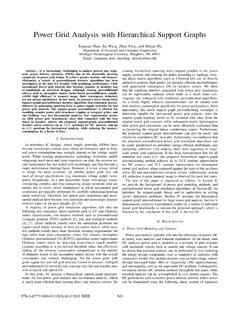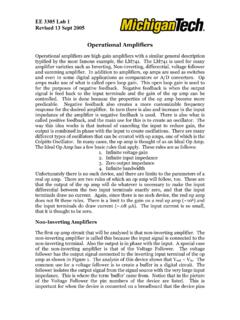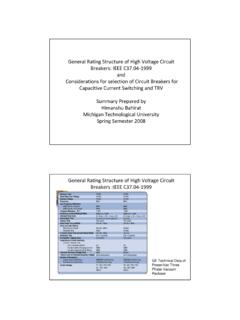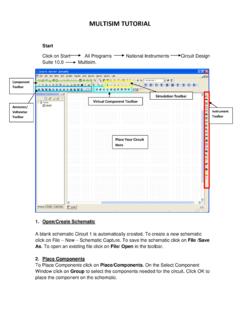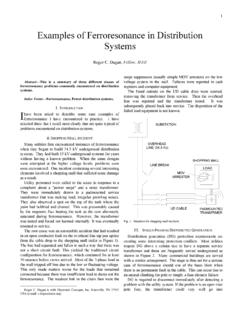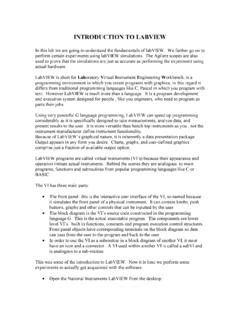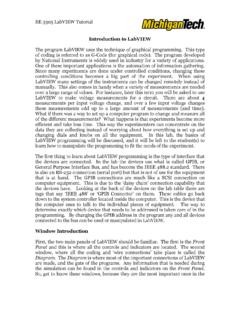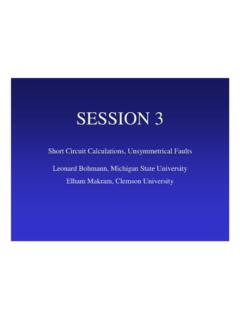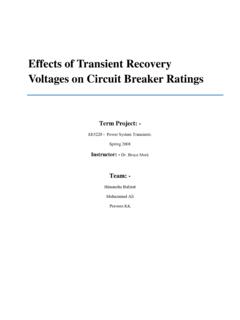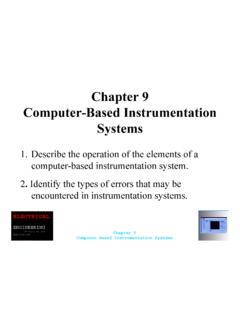Transcription of R Introduction to Electronics
1 RCRC ib2 ib1r r ib2ib1 REB( +1)ib2( +1)ib1vid /2vid /2vod vo1 vo2 +++++-----vXRCRC ib2 ib1r r ib2ib1 REB( +1)ib2( +1)ib1vid /2vid /2vod vo1 vo2 +++++-----vXIntroduction toElectronicsAn Online TextBob ZulinskiAssociate Professorof Electrical EngineeringMichigan Technological UniversityVersion Introduction to Electronics iiDedicationHuman beings are a delightful and complex amalgam ofthe spiritual, the emotional, the intellectual, and the is dedicated to all of them; especially to thosewho honor and nurture me with their friendship and to Electronics iiiTable of ContentsPreface xviPhilosophy of an Online xviNotes for Printing This Notice and of Linear Circuit Techniques 1 Resistors in 1 Resistors in 1 Product Over Sum 1 Inverse of Inverses 1 Ideal Voltage 2 Ideal Current 2 Real 2 Voltage 3 Current 4A quick exercise 4 What s missing from this review???.. 5 You ll still need Ohm s and Kirchoff s Laws 5 Basic Amplifier Concepts 6 Signal 7 Ground 7To work with (analyze and design) 7 Voltage Amplifier Model 8 Signal 8 Amplifier 8 Amplifier 8 Open-Circuit Voltage 9 Voltage 9 Current 10 Power 10 Introduction to Electronics ivPower Supplies, Power Conservation, and Efficiency 11DC Input 11 Conservation of 12 Amplifier Cascades 13 Decibel Notation 14 Power 14 Cascaded 14 Voltage 14 Current 15 Using Decibels to Indicate Specific 15 Voltage levels.
2 15 Power levels 16 Other Amplifier Models 17 Current Amplifier 17 Transconductance Amplifier 18 Transresistance Amplifier 18 Amplifier Resistances and Ideal Amplifiers 20 Ideal Voltage 20 Ideal Current 21 Ideal Transconductance 22 Ideal Transresistance 23 Uniqueness of Ideal 23 Frequency Response of Amplifiers 24 Terms and 24 Magnitude Response 24 Phase Response 24 Frequency Response 24 Amplifier Gain 24 The Magnitude 25 Causes of Reduced Gain at Higher 26 Causes of Reduced Gain at Lower 26 Introduction to Electronics vDifferential Amplifiers 27 Example: 27 Modeling Differential and Common-Mode 27 Amplifying Differential and Common-Mode 28 Common-Mode Rejection 28 Ideal Operational Amplifiers 29 Ideal Operational Amplifier 29Op Amp Operation with Negative 30 Slew 30Op Amp Circuits - The Inverting Amplifier 31 Voltage 31 Input 32 Output 32Op Amp Circuits - The Noninverting Amplifier 33 Voltage 33 Input and Output 33Op Amp Circuits - The Voltage Follower 34 Voltage 34 Input and Output 34Op Amp Circuits - The Inverting Summer 35 Voltage 35Op Amp Circuits - Another Inverting Amplifier 36 Voltage 36Op Amp Circuits - Differential Amplifier 38 Voltage 38Op Amp Circuits - Integrators and Differentiators 40 The 40 The 41 Introduction to Electronics viOp Amp Circuits - Designing with Real Op Amps 42 Resistor 42 Source Resistance and Resistor 42 Graphical Solution of Simultaneous Equations 43 Diodes 46 Graphical analysis of Diode Circuits
3 48 Examples of Load-Line 49 Diode Models 50 The Shockley 50 Forward Bias Approximation 51 Reverse Bias Approximation 51At High Currents 51 The Ideal 52An Ideal Diode Example 53 Piecewise-Linear Diode 55A Piecewise-Linear Diode Example 57 Other Piecewise-Linear 58 Diode Applications - The Zener Diode Voltage Regulator 59 Load-Line analysis of Zener 59 Numerical analysis of Zener 61 Circuit analysis 62 Zener Regulators with Attached 63 Example - Graphical analysis of Loaded Regulator 64 Diode Applications - The Half-Wave Rectifier 66A Typical Battery Charging 67 The Filtered Half-Wave 68 Relating Capacitance to Ripple Voltage 70 Introduction to Electronics viiDiode Applications - The Full-Wave Rectifier 721st (Positive) Half-Cycle 722nd (Negative) Half-Cycle 72 Diode Peak Inverse 73 Diode Applications - The Bridge Rectifier 741st (Positive) Half-Cycle 742nd (Negative) Half-Cycle 74 Peak Inverse 74 Diode Applications - Full-Wave/Bridge Rectifier Features 75 Bridge 75 Full-Wave 75 Filtered Full-Wave and Bridge 75 Bipolar Junction Transistors (BJTs) 76 Qualitative Description of BJT Active-Region 77 Quantitative Description of BJT Active-Region 78 BJT Common-Emitter Characteristics 80 Input 80 Output 81 Active Region 81 Cutoff 82 Saturation 82 The pnp BJT 83 BJT Characteristics - Secondary Effects 85 Introduction to Electronics viiiThe n-Channel Junction FET (JFET) 86 Description of 86 Equations Governing n-Channel JFET 89 Cutoff Region 89 Triode Region 89 Pinch-Off Region 89 The Triode - Pinch-Off 90 The Transfer 91 Metal-Oxide-Semiconductor FETs (MOSFETs)
4 92 The n-Channel Depletion 92 The n-Channel Enhancement 93 Comparison of n-Channel FETs 94p-Channel JFETs and MOSFETs 96 Cutoff Region 98 Triode Region 98 Pinch-Off Region 98 Other FET Considerations 99 FET Gate 99 The Body 99 Basic BJT Amplifier Structure 100 Circuit Diagram and 100 Load-Line analysis - Input 100 Load-Line analysis - Output 102A Numerical 104 Basic FET Amplifier Structure 107 Amplifier Distortion 110 Biasing and Bias Stability 112 Introduction to Electronics ixBiasing BJTs - The Fixed Bias Circuit 113 For b = 100 113 For b = 300 113 Biasing BJTs - The Constant Base Bias Circuit 114 For b = 100 114 For b = 300 114 Biasing BJTs - The Four-Resistor Bias Circuit 115 Circuit 116 Bias 117To maximize bias stability 118 For b = 100 (and VBE = V) 118 For b = 300 118 Biasing FETs - The Fixed Bias Circuit 119 Biasing FETs - The Self Bias Circuit 120 Biasing FETs - The Fixed + Self Bias Circuit 121 Design of Discrete BJT Bias Circuits 123 Concepts of 123 Design of the Four-Resistor BJT Bias 124 Design Procedure 124 Design of the Dual-Supply BJT Bias 125 Design Procedure 125 Design of the Grounded-Emitter BJT Bias 126 Design Procedure 126 analysis of the Grounded-Emitter BJT Bias 127 Introduction to Electronics xBipolar IC Bias Circuits 129 The Diode-Biased Current 130 Current Ratio 130 Reference Current 131 Output Resistance 131 Compliance 132 Using a Mirror to Bias an 132 Wilson Current 133 Current Ratio 133 Reference Current 134 Output Resistance 134 Widlar Current 135 Current Relationship 135 Multiple Current 137 FET Current 137 Linear Small-Signal Equivalent Circuits 138 Diode Small-Signal Equivalent Circuit 139 The 139 The 139
5 Diode Small-Signal 141 Notation 142 BJT Small-Signal Equivalent Circuit 143 The Common-Emitter Amplifier 145 Constructing the Small-Signal Equivalent 146 Voltage 147 Input 148 Output 148 Introduction to Electronics xiThe Emitter Follower (Common Collector Amplifier) 149 Voltage 150 Input 151 Output 152 Review of Small Signal analysis 153 FET Small-Signal Equivalent Circuit 154 The Small-Signal 155 FET Output 156 The Common Source Amplifier 157 The Small-Signal Equivalent 157 Voltage 158 Input 158 Output 158 The Source Follower 159 Small-Signal Equivalent 159 Voltage 160 Input 161 Output 162 Review of Bode Plots 164 The Bode Magnitude 165 The Bode Phase 166 Single-Pole Low-Pass 167 Gain Magnitude in dB 167 Bode Magnitude Plot 168 Bode Phase Plot 169 Single-Pole High-Pass 170 Bode Magnitude Plot 170 Bode Phase Plot 171 Introduction to Electronics xiiCoupling Capacitors 172 Effect on Frequency 172 Constructing the Bode Magnitude Plot for an 174 Design Considerations for RC-Coupled Amplifiers 175 Low- & Mid-Frequency Performance of CE Amplifier 176 Midband 177 Design 178 The Effect of the Coupling 179 The Effect of the Emitter
6 Bypass Capacitor 180 The Miller Effect 183 Deriving the 184 The Hybrid-p BJT Model 185 The 185 Effect of Cp and 186 High-Frequency Performance of CE Amplifier 189 The Small-Signal Equivalent 189 High-Frequency 190 The CE Amplifier Magnitude 192 Nonideal Operational Amplifiers 193 Linear 193 Input and Output Impedance 193 Gain and Bandwidth 193 Nonlinear 194 Output Voltage Swing 194 Output Current Limits 194 Slew-Rate Limiting 194 Full-Power Bandwidth 195 Introduction to Electronics xiiiDC 195 Input Offset Voltage, VIO 195 Input Currents 195 Modeling the DC 196 Using the DC Error 197DC Output Error 201 Finding Worst-Case DC Output Error 201 Canceling the Effect of the Bias 203 Instrumentation Amplifier 204 Simplified 205 Noise 206 Johnson 206 Johnson Noise Model 207 Shot 2071/f Noise (Flicker Noise).. 208 Other mechanisms producing 1/f noise 210 Amplifier Noise Performance 211 Terms, Definitions, 211 Amplifier Noise Voltage 211 Amplifier Noise Current 212 Signal-to-Noise Ratio 212 Noise Figure 213 Noise Temperature 213 Converting NF to/from Tn 214 Adding and Subtracting Uncorrelated 214 Amplifier Noise Calculations 215 Calculating Noise 216 Typical Manufacturer s Noise Data 217 Example # 218 Example # 219 Introduction to Electronics xivNoise - References and Credits 220 Introduction to Logic Gates 221 The 221 The Ideal Case 221 The Actual Case 221 Manufacturer s Voltage 222 Noise 222 Manufacturer s Current 223 Power 224 Static Power Consumption 224 Dynamic Power Consumption 224 Rise Time, Fall Time.
7 And Propagation 226 Speed-Power 227 TTL Logic Families & 228 CMOS Logic Families & 229 MOSFET Logic Inverters 230 NMOS Inverter with Resistive 230 Circuit Operation 230 Drawbacks 231 CMOS 232 Circuit Operation 232 Differential Amplifier 239 Modeling Differential and Common-Mode 239 Basic Differential Amplifier 240 Case #1 - Common-Mode Input 240 Case #2A - Differential Input 241 Case #2B - Differential Input 241 Large-Signal analysis of Differential Amplifier 242 Introduction to Electronics xvSmall-Signal analysis of Differential Amplifier 246 Differential Input 246 analysis of Differential 249 Differential Input Resistance 250 Differential Output Resistance 250 Common-Mode Input 251 analysis of Common-Mode 253 Common-mode input resistance 253 Common-mode output resistance 253 Common-Mode Rejection 254 Introduction to Electronics xvi1I use the word supposedly because, in my view, the official rewards for textbookauthoring fall far short of what is appropriate and what is achievable through an equivalentresearch effort, despite all the administrative lip service to the contrary.
8 These arguments,though, are more appropriately left to a different of an Online TextI think of myself as an educator rather than an engineer. And it haslong seemed to me that, as educators, we should endeavor to bringto the student not only as much information as possible, but weshould strive to make that information as accessible as possible,and as inexpensive as technology of the Internet and the World Wide Web now allowsus to virtually give away knowledge! Yet, we don t, choosinginstead to write another conventional text book, and print, sell, anduse it in the conventional manner. The whys are undoubtedlyintricate and many; I offer only a few observations: Any change is difficult and resisted. This is true in the habitswe form, the tasks we perform, the relationships we is simply easier not to change than it is to change. Thoughchange is inevitable, it is not well-suited to the behavior of anyorganism.
9 The proper reward structure is not in place. Faculty aresupposedly rewarded for writing textbooks, thereby bringingfame and immortality to the institution of their Therecognition and reward structure are simply not there for a textthat is simply posted on the web. No economic incentive exists to create and maintain aIntroduction to Electronics xviistructure that allows all authors to publish in this manner; thatallows students easy access to all such material, and thatrigorously ensures the material will exceed a minimumacceptable I were to do this the way I think it ought to be done, I would haveprepared the course material in two formats. The first would be atext, identical to the textbooks with which you are familiar, butavailable online, and intended to be used in printed form. Thesecond would be a slide presentation, la Corel Presentations or Microsoft PowerPoint , intended for use in the classroom or inan independent , alas, I am still on that journey, so what I offer you is a hybrid ofthese two concepts: an online text somewhat less verbose than aconventional text, but one that can also serve as classroomoverhead compromises have been made.
10 It would be advantageous toproduce two online versions - one intended for use in printed form,and a second optimized for viewing on a computer screen. The twowould carry identical information, but would be formatted withdifferent page and font sizes. Also, to minimize file size, andtherefore download times, font selection and variations aresomewhat limited when compared to those normally encounteredin a conventional may also note that exercise problems are not included with thistext. By their very nature problems quickly can become worn out. I believe it is best to include problems in a separate all of these enhancements exist, I hope you will find this asuitable and worthwhile compromise. Enough of this; let s get on with to Electronics xviiiNotes for Printing This DocumentThis document can be printed directly from the Acrobat Reader -see the Acrobat Reader help files for you wish to print the entire document, do so in two sections, asmost printer drivers will only spool a maximum of 255 pages at Notice and InformationThis entire document is 1999 by Bob Zulinski.
